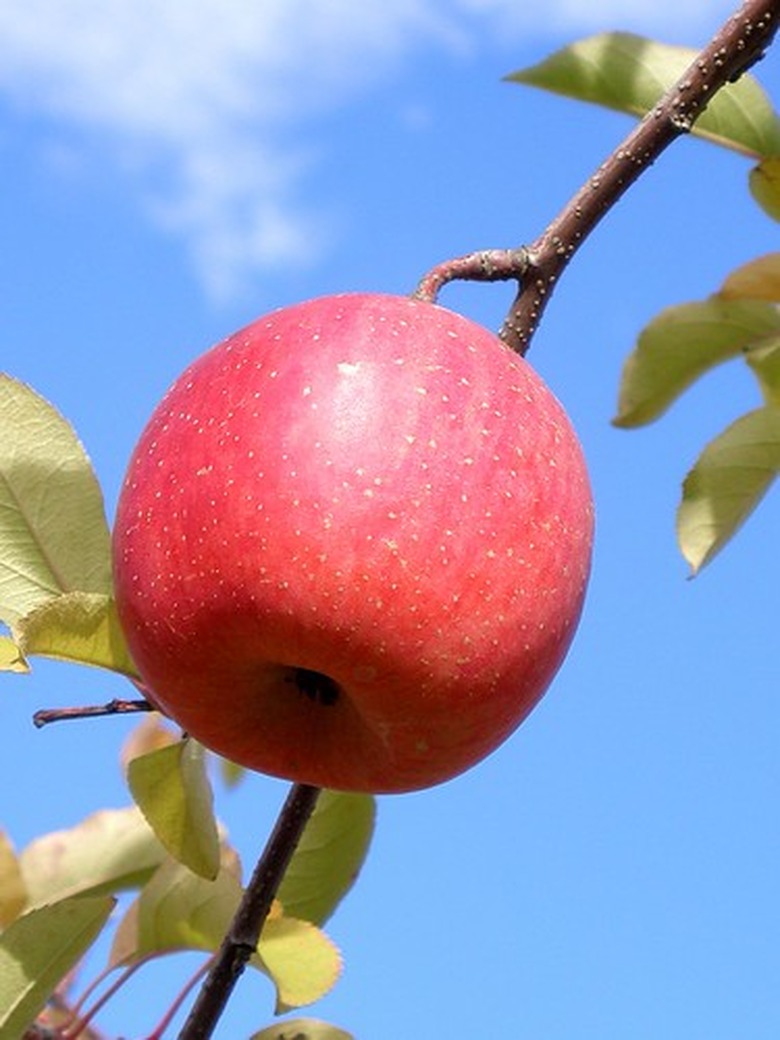When To Spray Apple Trees For Worms
Apple trees can easily become infested with a variety of insect pests, particularly the coddling moth. Left unchecked, they can decimate the harvest from an orchard or even a single tree in short order, perhaps as quickly as one summer. Following a schedule of spraying and employing other gardening techniques can minimize the damage.
Coddling Moth
The coddling moth itself does no damage to the tree. It overwinters in the tree and as temperatures warm up, they awake, mate and lays eggs in the bark and on the branches of the apple tree. The eggs hatch in two to four weeks. The larvae or "apple maggots" or "apple worms" seek out the fruit and burrow in, passing through several stages of development before emerging as moths and starting the process over again. A female coddling moth can lay between 50 and 100 eggs in her month of life. The cycle repeats two to three times a season, more often in warmer climates where the growing season is longer.
- Apple trees can easily become infested with a variety of insect pests, particularly the coddling moth.
- It overwinters in the tree and as temperatures warm up, they awake, mate and lays eggs in the bark and on the branches of the apple tree.
Spraying Insecticides
The ideal time to treat the infestation is before the moths have had a chance to lay eggs. Spray horticultural petroleum oil over the surface of the tree when daytime temperatures reach 45 to 55 Fahrenheit when there is no frost danger predicted for the night. Apply Esfenvalerate, Spinosad, Permethrin or Kaolin clay 17 to 21 days after full bloom of flowers or 10 days after all the petals have fallen off. These treatments remain active for one to two weeks. Additional treatments will be required every one to two weeks throughout the summer to disrupt the mating the mating cycle.
Insecticidal Soap
Insecticidal soaps, considered a safer, greener pesticide, can be applied as an alternative at the same time. They are effective in killing females and any larvae the soaps come in contact with but lose their effectiveness as soon as they dries. This method would require many applications to ensure full coverage throughout the growing season.
- The ideal time to treat the infestation is before the moths have had a chance to lay eggs.
- Spray horticultural petroleum oil over the surface of the tree when daytime temperatures reach 45 to 55 Fahrenheit when there is no frost danger predicted for the night.
Traps
The use of "mock apples" can alert you as to when adult coddling moths have emerged so that you can begin your treatments. They can also act as lures, attracting females away from real apples. Commercially prepared apples can be made of plastic and contain a pheromone that attracts the female. The apples are coated with a sticky substance that traps the adult moth, making her unable to lay eggs in the tree. Homemade apples can be made of a Styrofoam ball painted red to simulate an apple. Coat it with a sticky substance and hang a couple, homemade or commercial in each tree.
Maintenance
Another important step in protecting your apple tree from infestation is maintenance. Clean up apples as they fall. Apples on the ground are just as inviting to the moths and their larvae as those on the tree. Removing them reduces the number of paces for larvae to feed and grow. A summer and fall clean up fallen apples is recommended. Also, remove any apples from the tree that show "stings," the shallow entry points on the apple where the larvae have eaten their way into the fruit. This greatly reduces the number of larvae that can reach adulthood and repeat the cycle.
- The use of "mock apples" can alert you as to when adult coddling moths have emerged so that you can begin your treatments.
- The apples are coated with a sticky substance that traps the adult moth, making her unable to lay eggs in the tree.
